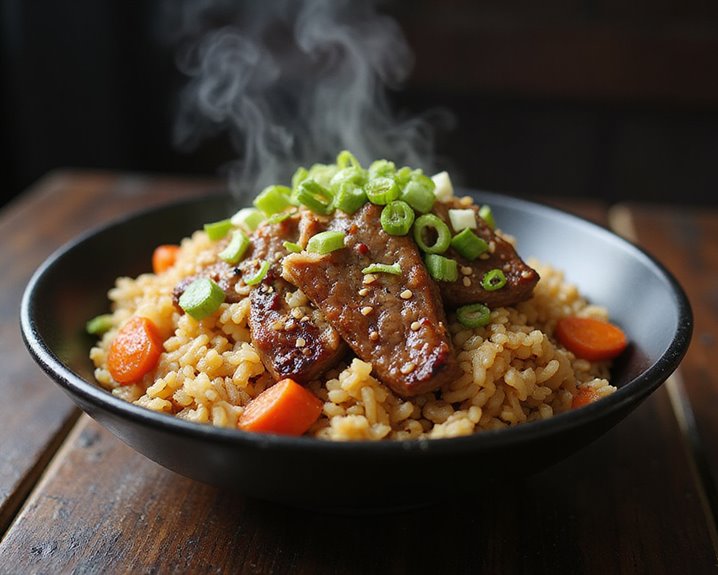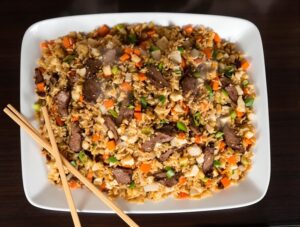Why You’ll Love this Steakhouse Hibachi Fried Rice
If you’ve ever sat at a hibachi grill, mesmerized by the flying spatulas and onion volcanos, you already know there’s something magical about hibachi fried rice. This homemade version brings that same steakhouse magic right to your kitchen, minus the theatrical knife tricks (which, let’s be honest, would end badly in my hands).
What makes this recipe so crave-worthy? For starters, it features tender sirloin strips and day-old rice that soaks up all that savory butter and soy sauce. The combination of crisp vegetables, sesame seeds, and that signature hibachi flavor creates the perfect balance of textures and tastes. And unlike restaurant versions, you can customize the seasonings to your preference. Ready in under 30 minutes, it’s quicker than a dinner reservation, too.
What Ingredients are in Steakhouse Hibachi Fried Rice?
When making authentic hibachi fried rice at home, having the right ingredients on hand makes all the difference between an ordinary dish and restaurant-quality perfection. The beauty of this recipe lies in its simplicity—everyday ingredients transformed through proper technique into something truly crave-worthy. Ready to recreate that steakhouse magic in your own kitchen?
- 5 cups white rice (cooked the day before and chilled)
- 1 bunch green onions, chopped
- 1/4 cup diced carrots
- 1/2 cup diced onion
- 2 tablespoons minced garlic
- 1/2 cup soy sauce
- 1/2 pound sirloin, cut into thin bite-size strips
- 3/4 cup butter, sliced into 8-10 pieces
- Salt and pepper to taste
- Vegetable oil for cooking
- 1/4 cup sesame seeds
The secret to truly authentic hibachi fried rice? Using day-old rice. Fresh rice contains too much moisture and tends to clump together, while rice that’s been refrigerated overnight dries out slightly, creating that perfect separated grain texture we all love from hibachi restaurants. And don’t skimp on the butter—it might seem like a lot, but that rich, savory flavor is what gives steakhouse fried rice its distinctive taste that keeps us coming back for more. Not a beef fan? This recipe works beautifully with chicken, shrimp, or purely vegetarian versions too.
How to Make this Steakhouse Hibachi Fried Rice

To begin this restaurant-worthy hibachi fried rice, heat about two tablespoons of vegetable oil in a large skillet over medium-high heat. Once the oil is nice and hot (you’ll know when it shimmers slightly), add your vibrant mix of vegetables: 1/4 cup diced carrots, 1/2 cup diced onion, 1 bunch of chopped green onions, and 2 tablespoons of minced garlic. This colorful medley needs to cook for about 3-4 minutes with frequent stirring. The aroma that fills your kitchen at this point? Pure magic. For even better results, consider using a wok cooking system which provides superior heat distribution and authentic Asian-style cooking capabilities.
When the veggies have softened but still maintain a slight crunch, transfer them to a plate and set aside.
Now for the star of the show—the beef. Return your skillet to the stove and add another tablespoon of oil over medium-high heat. Add 1/2 pound of sirloin (cut into thin, bite-sized strips) with a sprinkle of salt and pepper, plus a couple pats from your 3/4 cup of butter. Let the beef sizzle and brown for 3-4 minutes, stirring occasionally. Can you smell that steakhouse aroma yet? Using a slotted spoon, transfer the beef to the same plate as your vegetables, and discard any remaining juices from the pan.
The final step is where everything comes together. Return your pan to the stove and add 5 cups of day-old white rice (the secret to perfect fried rice!), the remaining butter, 1/2 cup of soy sauce, salt and pepper to taste, and 1/4 cup of sesame seeds. Stir constantly over medium-high heat until everything is well incorporated and heated through, creating that signature hibachi-style fried rice that’s both buttery and savory.
Steakhouse Hibachi Fried Rice Substitutions and Variations
While the classic hibachi fried rice recipe is absolutely delicious as written, there’s plenty of room to customize this dish based on what you have on hand or your dietary preferences.
You can swap sirloin for chicken, shrimp, or tofu for a different protein experience. Vegetarians might skip the meat entirely and double up on veggies.
Brown rice works beautifully as a healthier alternative to white rice, though you’ll need a bit more liquid.
Don’t have carrots or onions? Try peas, corn, or diced bell peppers. For a flavor twist, I recommend adding a tablespoon of oyster sauce or a dash of sesame oil. Can’t do soy sauce? Coconut aminos make a wonderful substitute. And if you’re feeling adventurous, why not crack an egg into the hot rice for that authentic hibachi experience?
What to Serve with Steakhouse Hibachi Fried Rice
Although hibachi fried rice can stand alone as a complete meal, pairing it with complementary sides elevates your dining experience to restaurant-quality status. I recommend serving it with some grilled vegetables like zucchini, mushrooms, and broccoli tossed in a light sesame oil. Nothing beats that smoky char!
For protein lovers, consider adding some hibachi-style shrimp or chicken—perfectly seared with a touch of garlic butter. Mmm, can you imagine that sizzle?
A small bowl of miso soup makes an excellent starter, while a crisp cucumber salad with rice vinegar dressing provides a cooling contrast to the rich, buttery rice. Want something to cleanse the palate? A side of ginger-infused pickles works wonders between bites.
Final Thoughts
Mastery of hibachi fried rice brings restaurant-quality flavors right to your kitchen table. There’s something deeply satisfying about recreating that steakhouse experience at home, especially when the aroma of butter-sizzled rice and savory beef fills your kitchen. Don’t stress if your first attempt isn’t perfect—cooking hibachi style takes practice, but that’s part of the fun.
Remember, day-old rice is non-negotiable for authentic texture. And those butter pieces? They’re the secret weapon that transforms ordinary fried rice into something special. Feel free to adjust the soy sauce to your taste or swap in different proteins.
What I love most about this recipe is its versatility. Make it for weeknight dinners or weekend gatherings—either way, you’ll have everyone asking for seconds.

